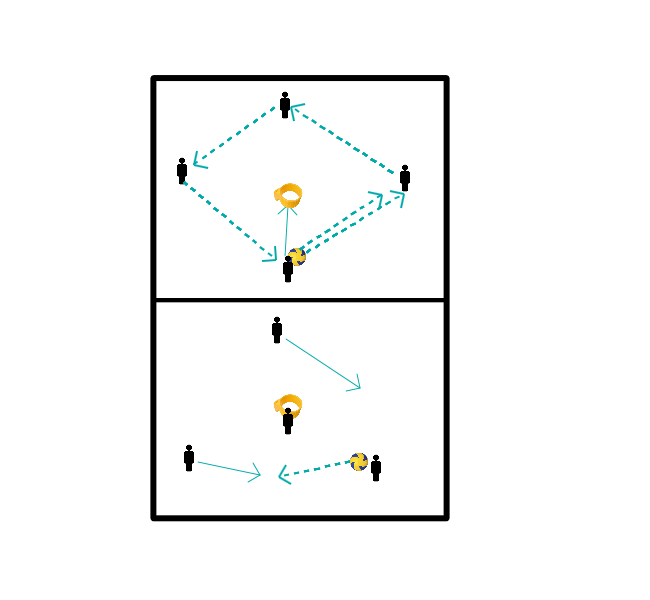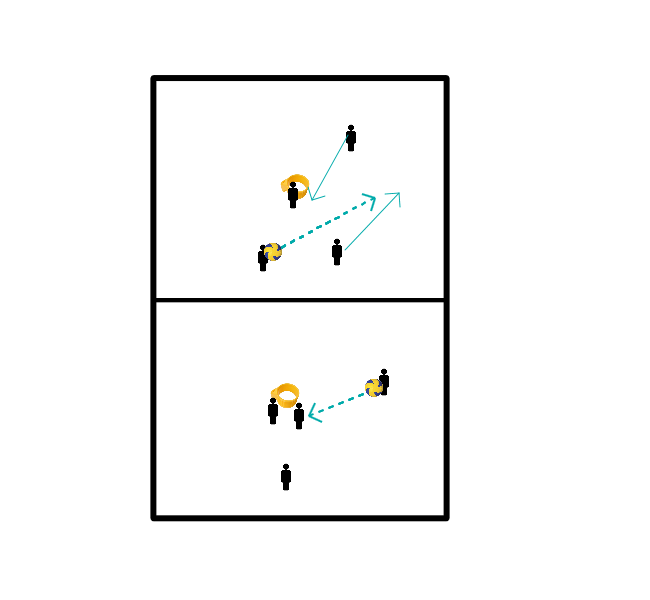Korfball drills for technique attack / score
The exercise starts in the 4-0 formation. The ball is passed from player 1 to player 2, after which player 1 fills the rebound-position. Player 3 fills the gap left by player 1 by connecting to the front. This creates space for player 4 to connect behind the basket. With this the 3-1 is realised, players 2,3 and 4 form a triangle around the basket.
The next step is to make a pass, so towards the 2-2. Player 2 passes the ball to player 3, and player 4 passes to him. Timing is very important here. Player 4, the attacker, must pass to the attacker just in time. If he is too early, his defender can pass to him, if he is too late the defender of player 3 can recover his defensive position. The perfect timing is therefore that player 3 can pass the ball as soon as he receives it, and that player 4 is not waiting for the ball.
As soon as player 4 with the ball is in the passing position, both shooters, players 2 and 3, have to make an action to get a shot. This can be a dodging move or a wide move. The initiator, player 4, chooses a shooter (in the video player 2) and passes the ball to the shooter. The shooter takes a shot, and the rebounder, player 1, catches the ball. The player who did not make the shot (in the video, player 3) keeps moving and gets the ball as soon as he is caught by player 1, and still makes the shot. This can be called the bonus shot. Why is this shot important? It forces both players to keep moving, and they get a reward in the form of a shot. Player 1 catches the ball again, and the exercise is over.
Everyone turns one spot and the exercise can start again.
- 1 declarer throws the ball to the person in front of the basket then he takes a shot if the ball is caught under the basket he then goes inside and takes a through ball finally he then takes a short chance.
- Point count:
- Shot counts 2x
- Walkthrough counts 1x
- Short chance counts 1x
- 3 min long and then look per basket who has the most points
In short: nice shooting exercise with a lot of running.
Organisation:
- The baskets are placed in a circle.
- At each basket stands a server with a ball.
- The rest of the players stand in the middle of the circle (the middle must be clearly recognisable.
- There is often a circle in the hall,
- A pylon must be placed on the field).
- The number of baskets is very precise:
- Aim for 2 baskets per 5 players.
Execution
- The players in the centre circle get the assignment to make a run through ball on one of the baskets,
- It does not matter which one.
- As there are more players in the circle than there are free baskets, it is important to find a free basket quickly.
- When you are not quick enough, you have to wait a bit.
- And when Johnny is already on his way to a basket, but is passed at the last moment by Marietje, who is running faster, Johnny has to go back to the centre circle and try again from there.
- Everyone catches his own ball.
- After passing the ball, each player runs through the centre circle or around the pylon to find a free basket again as soon as possible.
- First of all we have a support and a catch and 2 attackers 2 defenders a few meters in front of the basket.
- These two stand back to back.
- They both sprint to a corner and the one who is best free gets the ball and shoots.
- Alternatively, 1 attacker can be played and after that the ball is played straight back to the support for the through ball.
- 2-0 is meant to get rid of the opponent and use your fellow players as a block,
- Watch out for cutting off!
- Extend the game by having a defender take over under the basket and having the attacker sprint away and make a distance shot.
- When the group knows how to make the through ball, they can start with the technique with resistance from a defender.
- Not only the pace of the run-up is important, but also cutting off the defender's running line.
- A player is standing near the basket.
- Two players stand next to each other at a distance of 6 metres.
- One is attacker, the other defender.
- The attacker starts for the walkthrough, but in the meantime the defender tries to defend.
- The attacker must try to cut off the run of the defender immediately after the start.
- This means that when the runner starts to the left of the defender, the runner passes the basket on the left side.
- The runner therefore crosses the running line of the opponent
In short: a lot of shooting practice with a lot of running. (STRESS on learning to shoot on one leg at the end of the season plus stepping out with a throw).
Organisation: The baskets are placed in a square The number of baskets is very precise: aim for 5 baskets per 10 players.
a ) The players start at each basket, one person stands under the basket and the other person stands in the hoop in front of the basket with the ball, shoots on twolegs and goes on to the next basket.
changing: on time
in case of uneven numbers, run again or catch again.
b ) As a., but now with the assignment: Who will score 3 goals first?
c ) Like a., but with the assignment: pull one leg out of the hoop and the other leg up.
(for the ones who write with the right hand out of the hoop, SHOCK ON THE AIDE TRAINERS HERE TO HELP THEM)
d ) As a., but there is an 'over-taking situation': the runner from the circle, after having received the ball, plays the ball back to the declarer who started away from the post
(THE DECLARER STEPS OUT OF THE HOOP WITH ONE LEG TO THROW). The original declarator must try to score from this start. (NOW the one who shot the ball runs to the next corner).
change ; on time, or who scores 3 points first
In short: practise passing the ball from difficult situations.
Organisation: three or four teams per basket, one or two people under the basket, two in front of it. After marking the ball, walk forward to make a fastball, i.e. turn around.
(a ) Bouncing balls, indicated by a bounce.
(b ) Signalling too late: take overhead walkthroughs.
(c ) Signalling too late: the runner runs (left or right) past the basket and raises the ball more or less sideways or diagonally backwards.
(d) Late tagging: the runner runs along the near post and flings the ball over the head into the basket with one hand.
(e ) Marking too late: the ball is taken in the jump.
f ) The ball is passed too early: a 'long pull' must be taken with a long moment of suspension in the movement.
g ) The ball is not thrown in but rolled (can also occur in matches when the ball is knocked out of hands, or after an unsuccessful bouncing ball for example).
h ) the ball is indicated from the side, after which a through ball follows
With 3 players at the basket, 1 attacker with the ball under the basket and 2 players who shoot the ball in motion (minimum distance 3 meters
).
The attacker who is first to score 3 goals may remain in front of the basket and the attacker who has lost the game must take the place of the attacker.
- Make 2 squares of 4.
- The attack takes the ball from the trainers.
- When the defence has intercepted the ball, they first pass it back to the trainers.
- When a goal is scored, the team gets a bonus and can take the ball back out.
- Form 3 teams at the basket
- Person 1 stands 3 to 4 meters in front of the basket near the pawn.
- Person 2 will stand 3 to 4 meters behind the basket near the pawn.
- Person 3 stands under the basket as catcher
- Person 1 starts shooting, person 3 catches the ball and throws it to person 2.
- Person 2 shoots, person 1 catches and throws to person 3. Always change.
Exercises with distance shot, penalty throw and walkthrough.
- Make 2 squares of 4.
- The attack takes the ball from the trainers.
- When the defence has intercepted the ball, they first pass it back to the trainers.
- When a goal is scored, the team gets a bonus and can take the ball back out.
Do give orders, for example:
- Start in a diamond. Let the ball go around 1 time.
- The player in front throws the ball next to him/her one more time and catches it.
- The other players continue playing. The player who has the ball now chooses whether he wants to throw to the left or to the right. The other players run to the ball to pick it up. The ball is thrown and the player immediately runs a long line.
The long line is nudged and the thrower comes alongside. The other player walks behind the basket to walk into the support. The other two are going to attack.










